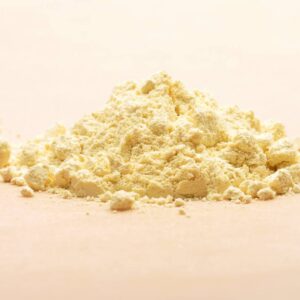Research Focus and Objectives
Argues for the increased cultivation and utilization of lupins in Europe as a sustainable alternative to imported soybean for both food and feed.
Addresses various aspects of the lupin food supply chain, from breeding and cultivation to processing and consumer acceptance.
Key Points
Dependence on Soybean Imports:
Europe relies heavily on soybean imports, which raises concerns about trade agreements and quality standards.
There is a need for alternative protein sources that align with European citizens’ expectations.
Lupins as a Viable Alternative:
White, yellow, and narrow-leafed lupins are native European legumes with high-quality protein content.
They offer potential health benefits and are suitable for sustainable production.
Challenges in Lupin Cultivation:
Lupin cultivation in Europe is insufficient to guarantee a steady supply for the food industry.
Insufficient grain yield, partly due to limited breeding efforts, is a significant barrier.
Breeding and Genetic Improvement:
Advanced breeding techniques are needed to develop new lupin varieties suitable for socio-economically and environmentally sustainable cultivation.
Exploiting landrace germplasm can increase white lupin yield.
Identifying germplasm tolerant to abiotic stresses can expand lupin cultivation across Europe.
Genomic selection and genotyping-by-sequencing (GBS) are promising tools for improving complex traits.
Nitrogen Fixation and Soil Health:
Lupins form root nodules for biological nitrogen fixation (BNF), reducing the need for synthetic nitrogen fertilizers.
The Lupinus-Bradyrhizobium symbiosis is relatively tolerant to abiotic stresses.
Developing specific Bradyrhizobium strains with stress-tolerant lupin genotypes can promote lupin as a sustainable crop.
Quality Traits and Health Benefits:
Key quality traits include low alkaloid content and the conglutin-γ protein fraction (for controlling insulin resistance).
Lupin proteins influence lipid and glucose metabolism, as well as blood pressure levels.
Lupin contains the Fe-rich protein ferritin, which may help increase dietary iron intake.
Food Processing and Ingredient Development:
Food processing affects the techno-functional and bioactive properties of lupin proteins.
Technological approaches should be optimized to improve the production, cost-effectiveness, and sustainability of high-quality protein ingredients.
Pre-treatments like germination and electromagnetic microwave radiation can improve processing.
Dry milling with air classification is an alternative to wet extraction with lower energy and water demands.
Protein hydrolysates containing bioactive peptides are of interest for functional foods and nutraceuticals.
Safety Aspects:
Lupin allergy is rare, but cross-reactivity with peanut exists, necessitating proper labeling.
Conglutins-α, -β, -γ, and -δ are candidate allergens in lupin.
Consumer Acceptance and Market Trends:
Lupin ingredients are used in foods but less commonly than soybean or pea ingredients.
Lupin flour can supplement food products and serve as an egg substitute.
Focus should be on developing lupin-based foods that replace animal products and cater to trends like naturalness, vegetarianism, and health properties.
Supply Chain Assessment:
The supply chain must be assessed for production costs, yields, quality, and consumer acceptance.
Addressing factors contributing to low lupin production and increasing supply are essential.
Life-cycle assessment methods (LCA) and participatory impact assessment techniques should be combined.
Conclusion
Europe needs to promote an integrated strategy to establish lupins as a high-value protein source, capable of promoting socio-economic growth and environmental benefits.
Summary
Objective: Advocate for increased lupin cultivation in Europe as a sustainable alternative to soybean imports.
Problem: Europe’s heavy reliance on soybean imports raises concerns about trade and quality.
Solution: Lupins are native European legumes with high-quality protein and sustainability potential.
Challenges:
Insufficient lupin cultivation in Europe.
Limited breeding efforts and grain yield.
Breeding:
Advanced techniques needed for sustainable lupin varieties.
Genomic selection and GBS are promising tools.
Nitrogen Fixation:
Lupins fix nitrogen, reducing fertilizer needs.
Developing stress-tolerant Bradyrhizobium strains is crucial.
Quality and Health:
Focus on low alkaloid content and beneficial proteins.
Lupin influences metabolism and contains dietary iron.
Food Processing:
Optimize processing for high-quality ingredients.
Consider pre-treatments and dry milling techniques.
Safety: Address lupin allergy and cross-reactivity with peanuts.
Consumer Acceptance:
Develop lupin-based foods catering to current market trends.
Focus on animal product replacement and gluten-free options.
Supply Chain:
Assess production costs, yields, and consumer acceptance.
Address factors limiting lupin production.
Conclusion: An integrated strategy is needed to establish lupins as a valuable protein source in Europe, promoting socio-economic and environmental benefits.






